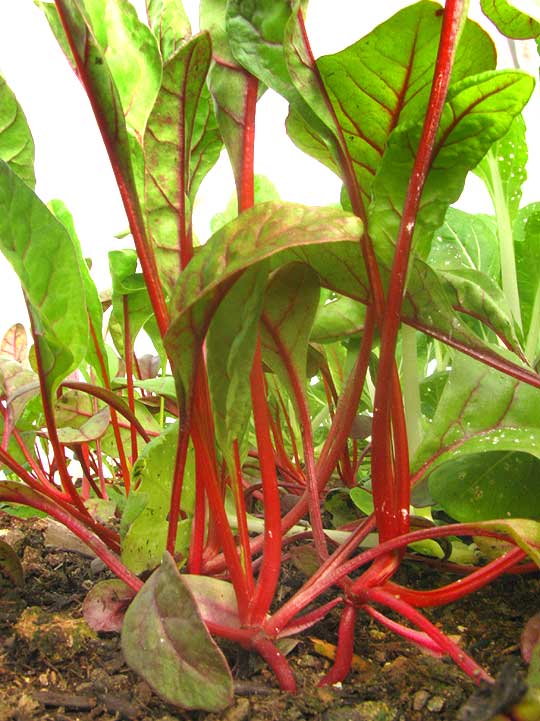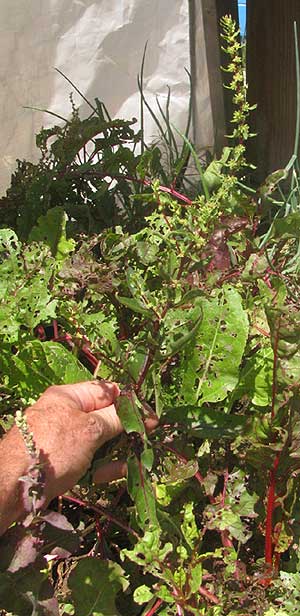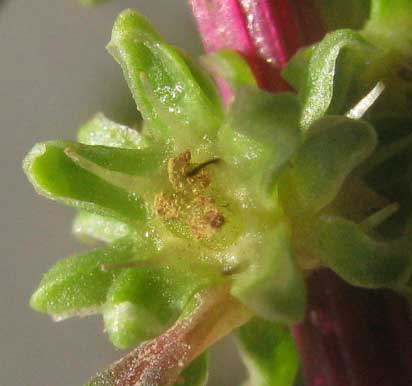Excerpts from Jim Conrad's
Naturalist Newsletter
from the November 24, 2013 Newsletter issued from the Frio Canyon Nature Education Center in the valley of the Dry Frio River in northern Uvalde County, southwestern Texas, on the southern border of the Edwards Plateau; elevation ~1750m (~5750 ft); N29.62°, W99.86°; USA
RED CHARD'S PIGMENT
We have a little greenhouse 10 x 10 feet square (3 x 3m) consisting of an aluminum frame covered with white plastic. Inside it, raised beds currently produce lush crops of mustard and turnip greens, bok choy, spinach, lettuce and chard. The white plastic doesn't admit as much light as I'd like, causing plants to grow a little spindly and thin-leafed, but that also makes the leaves softer for eating.
The chard is so pretty that I feel good just sitting next to it and feasting my eyes on its green leaves with their bright red stems and veins. When I put my face right down among the stems, I see what's shown below:

Some chard cultivars have red stems and veins while those of others are mostly white, green or yellow. The red-veined ones are prettier on the plate and thus more popular with most gardeners, though older green forms tend to out-produce the colorful hybrids.
I don't mind trading higher chard production for the pretty redness of red-stemmed chard cultivars, however. Chard is extraordinarily nutritious to begin with, and now it's known that red chard's redness is produced by a class of pigments that adds even more health benefits. Red chard's red pigment is produced by a class of pigments called betalains. If you've heard about the nutritional benefits of red beet juice, you've heard of the virtues of betalain pigments. Red garden beets and chard are cultivars of the same species, BETA VULGARIS, so betalains are behind the redness of both red beets and red chard.
Mainly, betalain has been shown to be a powerful antioxidant proven to prevent cardiovascular disease in humans, and certain studies suggest it may be beneficial in cases of cancer, osteoporosis, and neurodegenerative disease. Much more on the benefits of betalain is at http://www.whatarebetalains.com.
Another reason I like having betalain pigment showing up in my chard is that among flowering plants betalain occurs only among the ORDER of plants known as the Caryophyllales, which includes such closely related plant FAMILIES as the Amaranth, Portulaca, Cactus, Four-o'clock and Pokeweed Families. Chard belongs to the Amaranth Family.
The assumption is that about 110 million years ago -- during the Cretaceous Period when North America and Eurasia still formed one big landmass populated by the great dinosaurs -- a primitive plant from which all current members of the Caryophyllales arose began producing betalain pigment, possibly because of a genetic mutation. Now that plant's descendents, from amaranths to cacti, have inherited that trait. In the Caryophyllales, betalains take the place of anthocyanin pigments. So far it's not known why this group of plants produces betalains, but there's some evidence suggests that betalains may have fungicidal properties.
from the June 29, 2014 Newsletter issued from the Frio Canyon Nature Education Center in the valley of the Dry Frio River in northern Uvalde County, southwestern Texas, on the southern border of the Edwards Plateau; elevation ~1750m (~5750 ft); N29.62°, W99.86°; USA
CHARD FLOWERS
 Since writing the above piece I've eaten bushels of chard, but now the leaves are getting tough and bug-eaten, and some plants are
"bolting" -- issuing tall, slender flowering heads which later will provide seeds I'll collect for next year -- as you can see at the right
Since writing the above piece I've eaten bushels of chard, but now the leaves are getting tough and bug-eaten, and some plants are
"bolting" -- issuing tall, slender flowering heads which later will provide seeds I'll collect for next year -- as you can see at the right
We've seen that chard plants are pretty much the same as beet plants -- they're both Beta vulgaris -- just that humans have selectively bred the species until distinct cultivars have arisen, some producing thickened roots worthy of eating, others with roots producing lots of sweet carbohydrate (sugar beets) , and others with piddling roots, but large, pretty leaves for eating, and this later kind is what chard is.
Therefore, chard flowers and beet flowers are practically the same thing. If you've sown seeds of either you might remember that the seeds are weird looking things, irregularly shaped and bristling with low, blunt knobs. What kind of flower could produce such outlandish-looking seeds?
Part of the answer is that the "seeds" we sow aren't really seeds. They're achene-type fruits, and sometimes the fruits are grown together, adding to the confusion. Maybe you've noticed that when you plant one beet or chard "seed," two plants, sometimes more, emerge. Each fruit consists of a "disk" that in the original flower surrounded the base of the ovary, plus what became of the flower's calyx. After a chard/beet flower's ovary is fertilized, the disk and calyx enlarge and harden, surrounding the seed with their odd, almost woody irregularities.
So, the flowers producing strange-looking beet and chard seeds look fairly normal, except that they do grow in tight little clusters of two or more, so that it's easy to visualize them growing together and eventually producing fused-together fruits. Below, you can see a flower very closely growing with two others:

Interesting features include the five petal-like appendages being green and scoop-shaped, so that it's hard to say whether they're calyx sepals or corolla petals. They're in-between, in which case we call them tepals or perianth lobes. Note that stamens arise opposite the tepals, not alternating with them. The three curved, powdery, yellowish items in the flower's center are stigmas, which is where pollen lands and germinates. The stigmas stand atop the flattish ovary -- the future fruit -- which is partially embedded in the green, fleshy "disk" around its base. The stamens' filaments arise from this disk.
The beet/chard species, Beta vulgaris, is a member either of the Amaranth Family or the Goosefoot Family, depending on your expert. Recent gene sequencing data show that there's no clear difference in the families, so some experts sink the Goosefoot Family into the Amaranth Family, but other authorities, such as those at the Flora of North America, keep them separate, "awaiting further studies."